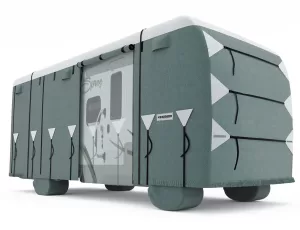Discovering Southern Arizona
While you’re in Tucson for FMCA’s 108th International Convention and RV Expo this March, avail yourself of the many sightseeing opportunities in and around this fun town.
By Pat Jennette, F505807
January 2024
Southern Arizona offers plentiful and unique ways to experience the desert landscape. It’s home to wine trails, tall rock spires that reach high into the sky, and Western towns with authentic buildings that reflect a life lived when horses saddled up and cowboys settled in.
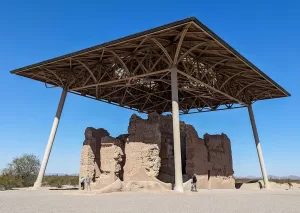
The “Great House” at Casa Grande Ruins National Monument is shielded by a giant structure.
On one of our cross-country RV excursions, we explored this portion of the Grand Canyon State. We checked out national park sites, a world-renowned cavern, and a real-deal Western town.
South of the Greater Phoenix area, Casa Grande Ruins National Monument stands tall on the desert floor. A massive metal canopy covers the remains of a fragile adobe structure known as the Great House, to protect it from further disintegration. Together with adjacent farmland, the monument preserves the ancestral Sonoran Desert peoples’ way of life. Tours of the grounds and exterior of the Great House are available, as several well-versed rangers tell the story of Casa Grande.
Boondocking in this desert landscape was nothing short of mesmerizing as we spent the night under dark skies and shooting stars.
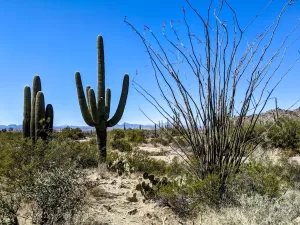
Saguaro cacti and other vegetation fill the desert landscape at Saguaro National Park.
The next stop was Saguaro National Park, home to the nation’s largest cacti. Saguaro is a short distance from Tucson and an easy day trip. We stopped at the new Red Hills Visitor Center on the west side of the park. Here, sit on the elevated patio and enjoy the silence of nature as a carpet of saguaros spreads out on the desert floor. Inside, the 15-minute film “Voices of the Desert” and the cultural and natural history exhibits educate visitors about the Sonoran Desert.
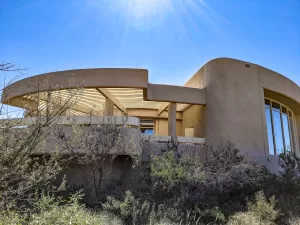
The Red Hills Visitor Center in Saguaro National Park provides a spectacular view from the balcony.
From there, we stayed overnight at Sonoita Vineyards, a Harvest Hosts site in Elgin. For those not familiar with Harvest Hosts, it is a membership organization offering places for RVers to stay across the United States, primarily wineries, breweries, museums, farms, and historic places. For a modest annual fee, members can stay overnight at more than 4,000 locations. By using Harvest Hosts, we’ve discovered many interesting places we’d never have known about otherwise.
Within a short drive of each other are two more national park sites: Coronado National Memorial and Tumacácori National Historical Park. The former site commemorates the Coronado Expedition of the early 1540s and its effect on Spanish and American Indian cultures. We weren’t able to explore Coronado, because we couldn’t take our large truck and RV setup up through the canyon. However, we spent time in the visitor center, spoke with the ranger, and then moved on to Tumacácori. There is ample parking along the road for all RV sizes.
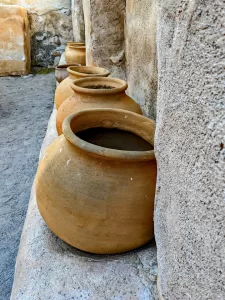
Explore the ruins and pottery at Tumacácori National Historical Park.
Tumacácori takes visitors back through time when missions were established along routes where travelers could stop and rest. People from all walks of life would settle down at the mission for short or even extended periods of time.
Archaeological buffs interested in learning more about old adobe earthen architecture will find plenty to explore. Multiple structures spread across the wide-open area give visitors a chance to see how people sheltered centuries ago.
The National Park Service website explains that here the O’odham, Yaqui, and Apache people met with European Jesuits and Franciscans. From the 1600s to the late 1800s, dozens of priests and missionaries would come to Tumacácori and stay for months or sometimes years. Here they would preach to and mentor the people who lived there or were traveling through.
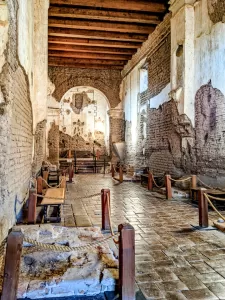
Tumacacori National Historical Park.
Paved trails and listening devices are available for those needing these services.
We had heard over the years that Kartchner Caverns was not to be missed in this area, so we took that advice. The caverns are located about 10 miles south of Benson. A delightful train ride takes visitors to the cavern entrance. Taking photos of the interior is not permitted, but some pictures are available for viewing on the cavern’s website. Limestone creates incredible formations within, and the tour is well organized.
The story goes that two young boys, Gary Tenen and Randy Tufts, were exploring the base of the Whetstone Mountains when they discovered the caverns. Several years later, they told the property owners, James and Lois Kartchner, about what they had found. The couple then approached Arizona State Parks about acquiring the property to preserve the caverns. In 1999, it officially became Kartchner Caverns State Park.
In this area, the wide-open grasslands of the Sierra Vista meet the mountain ranges of the Coronado National Forest. Small towns throughout the region, with names like Willcox and Tombstone, have their own personalities and offer places to eat, rest, and explore.
Willcox was established in 1880 when the Southern Pacific Railroad line made its way through the area as a shipping center for cattle and mining. The town’s rustic 1930s charm remains, and it serves as the starting point for the growing Willcox Wine Country. The wine trail has become so popular that several festivals are held here annually. Find more information on the website at willcoxwinecountry.org. Willcox is also home to the Rex Allen “Arizona Cowboy” Museum, the Southern Pacific Willcox Train Depot, and several other museums.
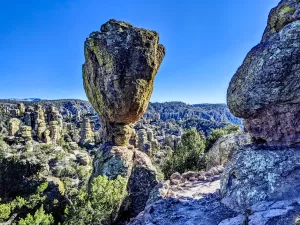
A massive rock formation sits precariously at Chiricahua National Monument.
Southeast of Willcox on Arizona State Route 181 is Chiricahua National Monument. We’ve heard that it’s being considered for national park status, and that’s not surprising. Known as the “Wonderland of Rocks,” Chiricahua displays a dizzying array of stone spires, pillars, and rock formations, with 17 miles of hiking trails interspersed throughout. We hiked portions of Echo Canyon Loop, Sugarloaf Mountain, and Massei Point.
Take a drive on the eight-mile-long road up to the top, where a lookout point jutting out over the rock formations provides a magnificent view.
According to the park’s website, southeastern Arizona is known for its avian diversity, and Chiricahua National Monument has been identified as an “Important Bird Area” by the American Bird Conservancy.
Chiricahua was established on April 18, 1924, by President Calvin Coolidge and celebrates its centennial this year. A schedule of events at the park can be found at nps.gov/chir/.
Bonita Canyon Campground is a no-hookup facility within the park and accommodates RVs up to 29 feet long. Since it is a National Park Service site, park pass holders get half off the regular $20-a-night rate. We chose instead to stay at Cattlerest RV Park and Saloon in Willcox, a Harvest Hosts site. We boondocked there for our first night and then paid a nominal fee to stay at the small RV park behind the saloon for the second night so we could have hookups. The park offers 14 full-hookup sites and can accommodate big rigs. Cattlerest offers an authentic “Old Western” flavor and experience. We enjoyed an evening of reasonably priced food and drinks at the saloon while watching the locals show off their square-dancing skills.
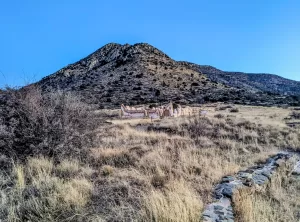
The ruins at Fort Bowie National Historic Site are tucked in between desolate desert mountains.
Next, we ventured off the beaten path through some of the most desolate lands we’d experienced yet in southeast Arizona as we headed in search of Fort Bowie National Historic Site. The roads were dusty and bumpy, and it was a long way to what seemed to be nowhere.
Little remains of Fort Bowie, and this quiet landscape belies its past. For 30 years during the late 1800s, Fort Bowie was an outpost for the United States Army as it held its place against the Chiricahua Apache until the surrender of Geronimo in 1886. It also was the site of the Battle of Apache Pass and a wagon-train massacre.
We arrived just as the visitor center had closed. Making a beeline past the gate and to the crest of the hill to see what we could of the site, we took photos of the minimal remains of this place named after commanding officer Colonel George Washington Bowie.
The upcoming FMCA 108th International Convention and RV Expo occurs in March, the same time of year as when we traveled through the area, and we can attest that the weather in Tucson was pleasant and sunny.
FURTHER INFO
Bonita Canyon Campground
Chiricahua National Monument
12856 E. Rhyolite Creek Road
Willcox, AZ 85643
nps.gov/chir/planyourvisit/bonita-canyon-campground.htm
(520) 824-3560
Cattlerest RV ParkAnd Saloon
933 S. Haskell Ave.
Willcox, AZ 85643
(520) 384-9213
Kartchner Caverns State Park
2980 S. Highway 90
Benson, AZ 85602
azstateparks.com/kartchner
(520) 586-4100
Sonoita Vineyards
290 Elgin-Canelo Road
Elgin, AZ 85611
sonoitavineyards.com
(520) 455-5893
The post Discovering Southern Arizona appeared first on Family RVing Magazine.
Source: https://familyrvingmag.com/2024/01/01/discovering-southern-arizona/


